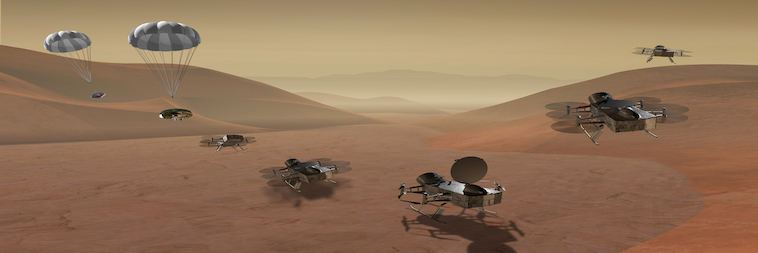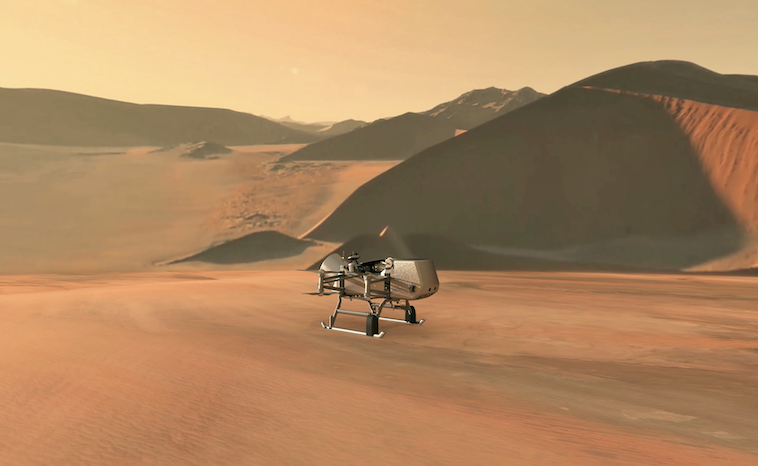NASA Robot Dragonfly Going To Saturn’s Titan
 NASA, Public domain, via Wikimedia Commons
NASA, Public domain, via Wikimedia Commons
NASA has announced that it plans to send a new rotorcraft to Saturn’s icy moon Titan. Read on to learn more about this exciting new mission.
Titan is larger than the planet Mercury and is the second-largest moon in our solar system. By 2026, NASA plans to launch its new rotorcraft Dragonfly. If everything goes well, it should arrive on Saturn’s moon Titan by 2034. The mission involves collecting research in the search for chemicals involved in the building blocks of life. It will be the first time that NASA has sent a multi-rotor vehicle for scientific purposes to another planet.
Dragonfly Mission
Dragonfly’s instruments will study how far prebiotic chemistry may have progressed on Titan. Furthermore, it will investigate the moon’s atmosphere as well as the rock hard water ice on the moon’s surface. In addition, Dragonfly will attempt to collect data from the subsurface ocean and liquid reservoirs on Titan. Titan’s subsurface water could be a place to harbor life as we know it. It is the only solar system body, other than Earth, known to have liquids on its surface. When referring to the moon’s surface liquids, it is not water like here on Earth. Titan’s surface lakes, rivers, and seas aren’t composed of water. However, the freezing moon’s climate system is based on hydrocarbons, in particular, methane and ethane.
The 10-foot-long (3 meters) Dragonfly will gather a variety of data at each of its stops. Dragonfly uses nuclear power like the Mars rover Curiosity. Each stopping point will help scientists learn more about Titan.
NASA/JHU-APL, Public domain, via Wikimedia Commons
Exploring Titan’s Moon
Once it has landed, Dragonfly will spend at least 2.5 years cruising around the 3,200-mile-wide (5,150 kilometers) moon. It will make two dozen flights that cover a total of about 110 miles (180 km). This is nearly double the distance traveled to date by all the Mars rovers combined.
NASA used date from the Cassini mission to determine the best time to launch and land Dragonfly. Cassini provided the information NASA needed to know which sites were interesting to explore.
It will first land at the equatorial “Shangri-La” dune fields. They are similar to the linear dunes in Namibia in southern Africa and offer a diverse sampling location. Dragonfly will explore this region on short flights. Eventually, it will begin a series of longer “leapfrog” flights of up to 5 miles (8 kilometers). (NASA, 2019) As it does, these leaps Dragonfly will take samples from interesting areas with different geographical features.
It will finally reach the Selk impact crater. This area looks the most interesting to NASA. For example, it has shown that it may contain liquid water from long ago. Furthermore, it may have complex molecules that contain carbon, combined with hydrogen, oxygen, and nitrogen. These things, combined with energy, make up life.
NASA’s Great Quest For Life
“Titan is unlike any other place in the solar system, and Dragonfly is like no other mission,” said Thomas Zurbuchen, NASA’s associate administrator for Science at the agency’s Headquarters in Washington. “It’s remarkable to think of this rotorcraft flying miles and miles across the organic sand dunes of Saturn’s largest moon, exploring the processes that shape this extraordinary environment. Dragonfly will visit a world filled with a wide variety of organic compounds, which are the building blocks of life and could teach us about the origin of life itself.” (NASA 2019)
Dragonfly will be the fourth mission in the New Frontiers Program. It follows New Horizons, the Juno probe to Jupiter, and the OSIRIS-REx asteroid-sampling mission.
Does Titan have the building blocks of life hidden in its icy surface? We will have to wait a little while to find out.
